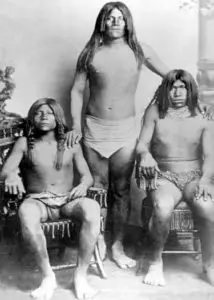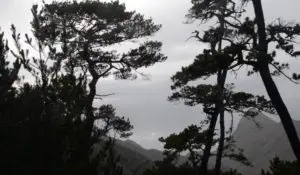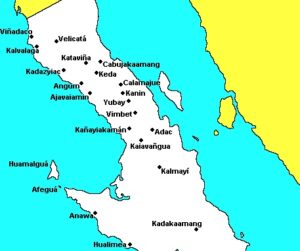Podcast: Play in new window | Download
Subscribe: Apple Podcasts | RSS
 Father Juan Bautista de Luyando was proud of his accomplishment. With his own private funds, the Jesuit priest had built a religious refuge near an oasis in the center of the Baja California Peninsula. At the site of the Cochimí settlement of Kadakaamán, which means “arroyo of reeds,” Luyando built the Mission of San Ignacio amid the tall palm trees. The year of its completion was 1728, and while the beautiful building was being constructed, the Jesuits began converting the local Cochimí population to Christianity. During that same year, the mission received a visit from 3 teenage boys. They had traveled a total of 8 days to get to San Ignacio, one on the sea and seven over land across the hot and inhospitable desert of Baja. The boys spoke a strange dialect, but the Cochimí at the mission could understand them. The newly Christianized Indians translated the tale of the boys’ journey but what interested the fathers the most was where exactly the boys came from. They described a large island one day’s voyage by boat off the west coast of the peninsula. The island once had many people but was recently decimated by a series of plagues. The island had lots of trees, many types of plants and animals and an overabundance of water. It was a place of plenty, a paradise on earth, shrouded in cool mists for most of the day. The people on the island were not completely isolated as they made occasional trips to the mainland to trade with coastal Cochimí, mostly animal skins for obsidian, to be used as arrowheads. The people on the island had heard about the strange newcomers on the mainland and the boys went to investigate. When the Jesuit fathers asked the name of the resplendent place the boys came from, one of them said, “Huamalgua.” This was translated to mean, “The Place of Fog” or “The Place of Mists.” The Spanish thenceforth called these people “Huamalgüeños.”
Father Juan Bautista de Luyando was proud of his accomplishment. With his own private funds, the Jesuit priest had built a religious refuge near an oasis in the center of the Baja California Peninsula. At the site of the Cochimí settlement of Kadakaamán, which means “arroyo of reeds,” Luyando built the Mission of San Ignacio amid the tall palm trees. The year of its completion was 1728, and while the beautiful building was being constructed, the Jesuits began converting the local Cochimí population to Christianity. During that same year, the mission received a visit from 3 teenage boys. They had traveled a total of 8 days to get to San Ignacio, one on the sea and seven over land across the hot and inhospitable desert of Baja. The boys spoke a strange dialect, but the Cochimí at the mission could understand them. The newly Christianized Indians translated the tale of the boys’ journey but what interested the fathers the most was where exactly the boys came from. They described a large island one day’s voyage by boat off the west coast of the peninsula. The island once had many people but was recently decimated by a series of plagues. The island had lots of trees, many types of plants and animals and an overabundance of water. It was a place of plenty, a paradise on earth, shrouded in cool mists for most of the day. The people on the island were not completely isolated as they made occasional trips to the mainland to trade with coastal Cochimí, mostly animal skins for obsidian, to be used as arrowheads. The people on the island had heard about the strange newcomers on the mainland and the boys went to investigate. When the Jesuit fathers asked the name of the resplendent place the boys came from, one of them said, “Huamalgua.” This was translated to mean, “The Place of Fog” or “The Place of Mists.” The Spanish thenceforth called these people “Huamalgüeños.”
 This island called Huamalgua by its inhabitants is called Isla Cedros today and is part of the Mexican state of Baja California. It was first visited in 1539 by Spanish explorer Francisco de Ulloa who landed on the island and found it heavily populated. As he was on a general survey of Mexico’s west coast, Ulloa had little interaction with the natives and did not stay long. He named the island “Cedros” which means “cedars,” in English, because of the cedar driftwood he found on the island’s beaches. He mistakenly believed that the pine forests he saw in the mountains of the islands were comprised of cedars, so the name stuck, at least for a while. Between the initial visit of the Ulloa expedition of 1539 and the arrival of the Huamalgüeño boys at the San Ignacio mission in 1728, the island saw few outside visitors. A few English and Dutch pirates knew of the island. It served as a brief hideout and freshwater stopover point for them while they preyed on unsuspecting galleons laden with Asian luxury goods making the trans-Pacific crossing to Mexico from the Spanish Philippines. Besides an occasional pirate visit, for almost two centuries the people of Cedros Island were left alone.
This island called Huamalgua by its inhabitants is called Isla Cedros today and is part of the Mexican state of Baja California. It was first visited in 1539 by Spanish explorer Francisco de Ulloa who landed on the island and found it heavily populated. As he was on a general survey of Mexico’s west coast, Ulloa had little interaction with the natives and did not stay long. He named the island “Cedros” which means “cedars,” in English, because of the cedar driftwood he found on the island’s beaches. He mistakenly believed that the pine forests he saw in the mountains of the islands were comprised of cedars, so the name stuck, at least for a while. Between the initial visit of the Ulloa expedition of 1539 and the arrival of the Huamalgüeño boys at the San Ignacio mission in 1728, the island saw few outside visitors. A few English and Dutch pirates knew of the island. It served as a brief hideout and freshwater stopover point for them while they preyed on unsuspecting galleons laden with Asian luxury goods making the trans-Pacific crossing to Mexico from the Spanish Philippines. Besides an occasional pirate visit, for almost two centuries the people of Cedros Island were left alone.
Scholars believe that this abundant island has been home to humans for over 11,000 years. In a 2017 excavation, archaeologists discovered what would later be determined to be the oldest fishhooks ever found in the Americas. These hooks were unearthed alongside bones of deep water fish which indicated that the early inhabitants of Cedros Island had the ability to build large boats that would take them miles offshore. No one knows the origins of these seafaring people, but perhaps some clues may be found in the legends of the Huamalgüeños themselves. When the Spanish established formal contact with the islanders, the Huamalgüeños told them that many years before two groups of people arrived at the island from the north and had found Cedros already inhabited. The newcomers fought with the original inhabitants, according to the legend, and completely wiped them out. No one knows how long ago this was and anything else about the original people on Cedros Island outside the artifacts first discovered in the 21st Century.
 What we know about the Huamalgüeños from the Spanish colonial period comes from an incredibly detailed manuscript called Obras Californianas, or “Californian Works,” compiled by Father Miguel Venegas. Father Venegas left to posterity a treasure trove of history, anthropology, biology and geography in this massive book, which took years for him to compile. Written in 1739, it is the most detailed work of history of the Baja Peninsula for this time period. Most of what we know about the Huamalgüeño people comes from this document. It is important to note that when Venegas mentions the term “California” in his book, he is referring to what we now know as Baja California, the peninsula comprised of two Mexican states. The territory of the US state of California, although known to the Spanish, did not have any European settlements at the time of this book’s publication in 1739.
What we know about the Huamalgüeños from the Spanish colonial period comes from an incredibly detailed manuscript called Obras Californianas, or “Californian Works,” compiled by Father Miguel Venegas. Father Venegas left to posterity a treasure trove of history, anthropology, biology and geography in this massive book, which took years for him to compile. Written in 1739, it is the most detailed work of history of the Baja Peninsula for this time period. Most of what we know about the Huamalgüeño people comes from this document. It is important to note that when Venegas mentions the term “California” in his book, he is referring to what we now know as Baja California, the peninsula comprised of two Mexican states. The territory of the US state of California, although known to the Spanish, did not have any European settlements at the time of this book’s publication in 1739.
After the visit of the Huamalgüeño boys to the San Ignacio mission in 1728, the Jesuits organized an expedition to find the island with the intention of bringing all the islanders to the mainland to integrate them into the Spanish mission system. Father Sebastian de Sistiaga, who oversaw the missions in Baja assigned Father Sigismundo Taraval to outfit the expedition, and a group of a few dozen men set out for the Pacific coast. In 1732, with the help of the Huamalgüeño boys as guides, the Spanish party made it to the Island of Mists and christened it “Isla de la Trinidad,” or “The Island of the Trinity.” The explorers were taken by the natural beauty and ample resources found there. From Father Venegas’ book he states:
 “Even much more than that was discovered one example is how different that land is from California in its abundance of waters. In that small space of the island there are up to four or five of arroyos in addition to other springs and water sources. Moreover, in order to find the many water sources in California one must walk many leagues. The waters of these arroyos and those of the springs are all of excellent quality. Aside from these there are various wells which are so well distributed that there were 3 landings for the watercrafts each with its own fresh water well.”
“Even much more than that was discovered one example is how different that land is from California in its abundance of waters. In that small space of the island there are up to four or five of arroyos in addition to other springs and water sources. Moreover, in order to find the many water sources in California one must walk many leagues. The waters of these arroyos and those of the springs are all of excellent quality. Aside from these there are various wells which are so well distributed that there were 3 landings for the watercrafts each with its own fresh water well.”
The Spanish chronicler said this about the animal life they found on their Isla de la Trinidad:
“The explorers recognized a greater difference in the animals of the island revealing how different it is from California. In the latter the bucks are so big that larger ones are not to be seen anywhere while on the island they are so small that they barely reach the size of a sheep. They also distinguished themselves in the hair which is thick and long and of the color of the mountain sheep. These deer would be taken for such if not for the fact that their antlers leave no doubt that they are deer. Of these there are many all over the island making up for their small size with their multitude. If the deer are small, then the rabbits are large. There is also a very small species of rabbit, all black, whose skins were brought as a specimen to the mission, and they have a great deal of very soft and delicate fur that surpasses the beaver’s.”
The explorers soon encountered the Huamalgüeños. Here is what Venegas has to say about the first contact:
“At the sudden sight of new people, the Islanders were filled with fright at the sight of their vestments since they had never seen clothed men. Some as they later said judged that the explorers were fiends, while others thought that they were sea monsters and finally others took them to be demons.”
Father Venegas later relates:
“The Islanders are different from the mainland Californians in that they have even fewer items of clothing which is as much as can be said of their rarity. The truth is they lack this necessity more by their own fault than for a lack of materials to provide such since they have – among other things – so many and such a variety of animal skins that they could to a large degree, if not completely, remedy their nakedness. The men’s personal possessions are reduced to their bow and arrow, a net, and a shell that serves as a cup with which to drink. However, they do not notice their lack. The woman’s personal possessions include a great net and a blanket or tray that they can form, not from the wooden sticks as in California, but of the roots of the agave plant that due to their material qualities are more flexible and durable. Among their items of clothing is a skirt that is the sole dress of the women. In size it is like that worn in California, but it is not made of carrizo reeds but of whale tendons. It should also be mentioned here that on the island the men go about totally naked like the Californians but the women there have less with which to cover themselves because aside from the skirt that they have in front they do not wear the deerskin that the California women use.”
Another thing of interest described later was the that the Huamalgüeños had wooden boards with small pictures painted on them and holes bored through them that may have served as rudimentary story books or other forms of forgotten written communications. The holy men of Cedros Island also had in their possession capes made of human hair that were extremely old and used in ceremonial occasions. Scholars are baffled by these interesting artifacts.
 The Spanish noted that there appeared to be several clans on the island, and while sometimes the clans quarreled, all islanders were represented by a king who ruled over everyone. At the time of the 1732 expedition there were about 400 Huamalgüeños living in a few villages and family encampments scattered throughout the island. The king was descended from the original leader who brought one of the two groups to the island from the north, the invasion that eliminated the original people of Cedros Island. Prior to the visit by the Jesuits, the king had heard about the Spanish mission system. When the Jesuit fathers made the king the proposition to relocate the entire population of the island to the mainland, the king made the decision for everyone and agreed to relocate his people. The islanders obeyed the king’s wishes without question. Over the ensuing months the Huamalgüeños abandoned their island paradise for the hot desert interior of Baja and a life under direct Spanish rule. The Spanish learned the unique Huamalgüeño dialect and learned about their religion, which, ironically had a set of 10 commandments that were radically different from those found in the Christian Bible. That notwithstanding, the Jesuit fathers rapidly Christianized the people from Fog Island. Once at San Ignacio, none of the Huamalgüeños ever returned to their heavenly homeland. Within 40 years of their exodus, most Huamalgüeños died off or intermarried with local Cochimís. By the beginning of the 1800s all vestiges of their culture were gone forever.
The Spanish noted that there appeared to be several clans on the island, and while sometimes the clans quarreled, all islanders were represented by a king who ruled over everyone. At the time of the 1732 expedition there were about 400 Huamalgüeños living in a few villages and family encampments scattered throughout the island. The king was descended from the original leader who brought one of the two groups to the island from the north, the invasion that eliminated the original people of Cedros Island. Prior to the visit by the Jesuits, the king had heard about the Spanish mission system. When the Jesuit fathers made the king the proposition to relocate the entire population of the island to the mainland, the king made the decision for everyone and agreed to relocate his people. The islanders obeyed the king’s wishes without question. Over the ensuing months the Huamalgüeños abandoned their island paradise for the hot desert interior of Baja and a life under direct Spanish rule. The Spanish learned the unique Huamalgüeño dialect and learned about their religion, which, ironically had a set of 10 commandments that were radically different from those found in the Christian Bible. That notwithstanding, the Jesuit fathers rapidly Christianized the people from Fog Island. Once at San Ignacio, none of the Huamalgüeños ever returned to their heavenly homeland. Within 40 years of their exodus, most Huamalgüeños died off or intermarried with local Cochimís. By the beginning of the 1800s all vestiges of their culture were gone forever.
REFERENCES
Des Lauriers, Matthew R. “The Watercraft of Isla Cedros, Baja California: Variability and Capabilities of Indigenous Seafaring Technology along the Pacific Coast of North America.” American Antiquity 70, no. 2 (2005): 342-60.
